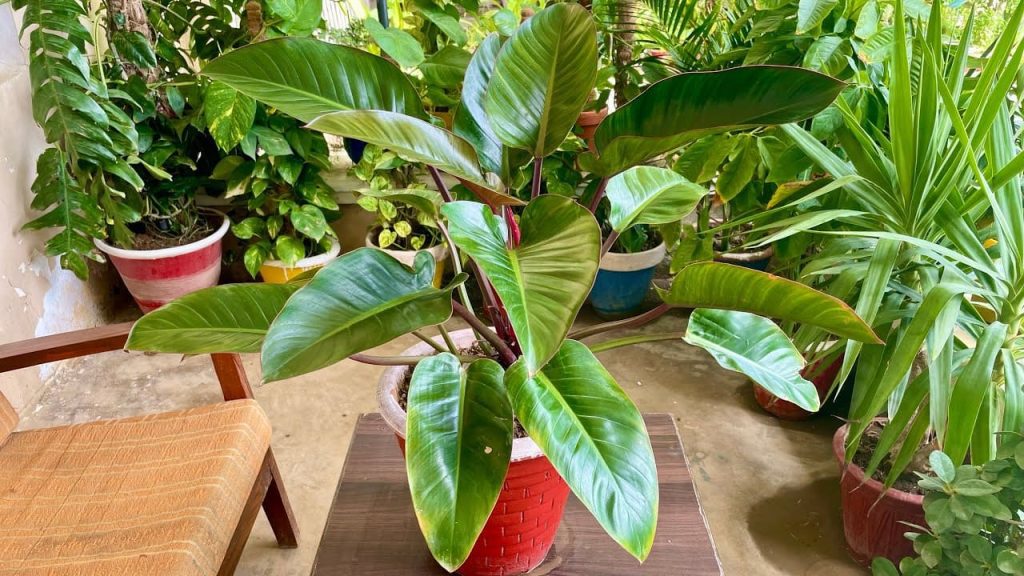Introduction
In recent years, houseplants have surged in popularity, transforming our living spaces into green havens. Among the most coveted varieties is Philodendron Erubescens, a stunning member of the Araceae family. Known for its striking foliage and resilience, this plant is perfect for both novice and experienced plant enthusiasts. In this article, we will explore the unique features, care requirements, and the benefits of incorporating Philodendron Erubescens into your home.
What is Philodendron Erubescens?
Philodendron Erubescens, commonly referred to as the “Red Emerald” or “Blushing Philodendron,” is a tropical plant native to South America. Its distinct characteristics include heart-shaped leaves that emerge in a vibrant red hue, which gradually matures to a rich green. This unique color transition, coupled with its climbing nature, makes it a popular choice for indoor gardening.
Key Features of Philodendron Erubescens
| Feature | Description |
|---|---|
| Family | Araceae |
| Height | Can grow up to 3-5 feet in optimal conditions |
| Leaf Shape | Heart-shaped leaves that can reach up to 12 inches |
| Light Requirements | Prefers bright, indirect sunlight |
| Watering Needs | Water when the top inch of soil is dry |
| Soil Type | Well-draining potting mix with organic matter |
| Humidity | Thrives in high humidity (60% or more) |
Care Requirements
Light
Philodendron Erubescens thrives in bright, indirect sunlight. Direct sunlight can scorch the leaves, while too little light can hinder growth. Placing your plant near a window with filtered light is ideal. If natural light is scarce, consider using grow lights to supplement.
Watering
The watering frequency depends on the environmental conditions. The top inch of the soil should be dry before watering. Overwatering can lead to root rot, while underwatering may cause the leaves to droop. It’s essential to maintain a balanced moisture level.
Soil
A well-draining potting mix is crucial for Philodendron Erubescens. A mixture of peat, perlite, and orchid bark provides excellent drainage while retaining enough moisture. You can also use a commercial potting mix formulated for aroids.
Humidity
This tropical plant enjoys humidity levels of 60% or higher. If your home is dry, consider misting the leaves, using a humidifier, or placing a tray of water near the plant to increase humidity.
Fertilization
During the growing season (spring and summer), fertilize every four to six weeks with a balanced, water-soluble fertilizer. Reduce feeding in the fall and winter when the plant’s growth slows down.
Common Problems and Solutions
Philodendron Erubescens is relatively low-maintenance but may encounter some issues. Here’s a table of common problems and their solutions:
| Problem | Symptoms | Solution |
|---|---|---|
| Yellowing Leaves | Leaves turning yellow | Check for overwatering or nutrient deficiencies |
| Drooping Leaves | Leaves wilting | Ensure proper watering and humidity levels |
| Brown Leaf Tips | Tips of leaves turning brown | Increase humidity or reduce direct sunlight |
| Pests (e.g., spider mites) | Visible webs or spots on leaves | Treat with insecticidal soap or neem oil |
Propagation Methods
Philodendron Erubescens is easy to propagate through stem cuttings. Follow these steps for successful propagation:
- Select a Healthy Stem: Choose a stem with at least one node and a few leaves.
- Cut the Stem: Use clean scissors or pruning shears to make a cut just below a node.
- Prepare the Cutting: Remove the lower leaves to expose the node.
- Place in Water or Soil: You can either place the cutting in water until roots develop or plant it directly into a pot with soil.
- Care for the Cutting: Keep the cutting in a warm, humid environment, ensuring it receives indirect light.
Benefits of Philodendron Erubescens
In addition to its aesthetic appeal, Philodendron Erubescens offers several benefits:
- Air Purification: Like many houseplants, it helps improve indoor air quality by filtering toxins from the air.
- Aesthetic Value: Its unique foliage adds a touch of nature to any space, enhancing interior decor.
- Easy Care: This plant is forgiving and adapts well to various conditions, making it perfect for beginners.
Frequently Asked Questions (Q&A)
Q: How often should I repot my Philodendron Erubescens?
A: It’s best to repot every 1-2 years or when the roots become root-bound.
Q: Can I grow Philodendron Erubescens outdoors?
A: Yes, it can thrive outdoors in USDA zones 9-11, but ensure it’s protected from direct sunlight and cold temperatures.
Q: Is Philodendron Erubescens toxic to pets?
A: Yes, it is toxic to cats and dogs if ingested. Keep it out of reach of pets and small children.
Q: What should I do if my plant grows too tall?
A: You can prune the stems to control the height or provide a moss pole for support to encourage climbing.
Conclusion
Philodendron Erubescens is more than just a beautiful plant; it’s a low-maintenance, air-purifying companion that can thrive in various environments. With the right care, this tropical beauty can flourish in your home, offering aesthetic and health benefits. Whether you’re a seasoned plant parent or just starting your indoor garden, consider adding Philodendron Erubescens to your collection and enjoy the beauty it brings.
References
- House Plant Journal: Philodendron Erubescens Care
- Gardenia: Philodendron Erubescens
- The Spruce: How to Care for a Philodendron

